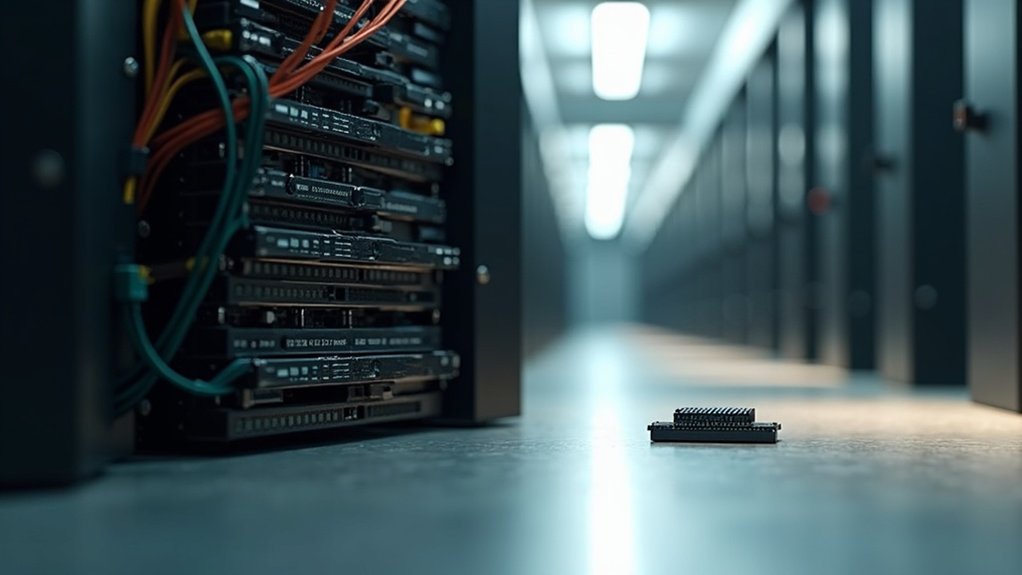Crypto nodes are computers that form the backbone of blockchain networks. They store complete copies of the transaction ledger and verify each transaction’s validity. When you send crypto, nodes check if you have funds, broadcast the info to other nodes, and permanently record it. Full nodes maintain the entire blockchain, while miners solve puzzles to create blocks. The decentralized nature of nodes makes blockchains incredibly secure. Hack one? Good luck controlling over half the network.
The backbone of blockchain technology isn’t flashy. It’s a network of computers called nodes, each quietly maintaining the entire system without fanfare. A crypto node is simply a device—could be your laptop, could be a massive server farm—running blockchain software and connected to the network. Nothing special to look at. Just machines doing their job.
Nodes don’t seek attention. They’re the quiet guardians keeping blockchain alive—ordinary machines performing extraordinary work.
These nodes store complete copies of the blockchain ledger. Every transaction. Every block. Every piece of data since the beginning. They’re digital librarians, except they don’t shush you for talking too loud. Their purpose? Verification. Nodes check that new transactions follow the rules before adding them to the blockchain. No central authority needed. The network polices itself.
When someone sends crypto from one wallet to another, nodes spring into action. They verify the sender has enough funds and broadcast this information to other nodes. It’s like a global game of telephone, except nobody messes up the message. Once verified, the transaction joins the blockchain permanently. Try erasing it later—you can’t. That’s the point.
Full nodes are the workhorses, storing everything and validating independently. Miner nodes solve those famous cryptographic puzzles to create new blocks. These transactions first enter each node’s mempool as pending before being processed further. Some networks have light nodes too, which store partial data for efficiency. Different blockchain, different setup. Same principle.
Security comes from decentralization. To hack a blockchain, you’d need to control over half the nodes simultaneously. Good luck with that on networks with thousands of participants. Each node is a guardian, rejecting invalid transactions and preventing double-spending. They’re paranoid by design. They also communicate through a peer-to-peer network to maintain consensus on the blockchain’s state. Unlike miners who earn rewards for their work, regular nodes support the network by validating transactions voluntarily.
Nodes maintain constant communication, reaching consensus on transaction validity and order. It’s democracy in digital form. Messy, inefficient sometimes, but remarkably effective. This is how blockchains operate without CEOs or headquarters. Just code and consensus. Not very exciting to watch, but revolutionary in function.
Frequently Asked Questions
How Much Does It Cost to Run a Cryptocurrency Node?
Running a crypto node costs vary.
Hardware expenses include a decent computer with 2+ GHz CPU, 4+ GB RAM, and 500+ GB SSD storage—roughly $500-1,000 upfront. Monthly internet bills add up with 200+ GB data usage.
Electricity runs 60-150 watts continuously. Cheaper than mining, sure, but not free.
Cloud alternatives cost $20-100 monthly. The blockchain keeps growing, so storage needs increase.
No free lunch in crypto.
Can I Earn Passive Income by Operating a Node?
Yes, operating certain crypto nodes can generate passive income, but not all types.
Staking nodes in PoS networks and masternodes pay rewards for validation services.
Full nodes? Sorry, typically no direct income there.
Mining nodes earn rewards but require significant hardware and electricity costs.
The catch? You’ll need substantial collateral, reliable hardware, and stable internet.
Market volatility and potential slashing penalties make this income unpredictable.
Not exactly free money.
What Technical Skills Do I Need to Set up a Node?
Setting up a node requires a solid tech toolkit.
System administration skills are non-negotiable—you’ll need to install, configure, and maintain node software.
Hardware knowledge matters too: understanding CPU requirements, storage needs, and network connectivity.
Basic networking is essential—IP addressing, firewalls, port forwarding.
Don’t forget security fundamentals to protect against attacks.
Finally, you’ll need at least a functional understanding of blockchain architecture and the specific consensus mechanism you’re supporting.
Not exactly beginner territory.
How Much Internet Bandwidth Does Running a Node Require?
Running a crypto node demands serious bandwidth. Bitcoin needs at least 400 kbps upload speed, consuming around 200 GB monthly in uploads and 20 GB in downloads.
Ethereum? Way more demanding—300-500 Mbps for full nodes, with archive nodes preferring gigabit connections. No kidding.
The type matters too. Pruned nodes use less, validator nodes need stable connections.
And remember, most home internet plans offer faster download than upload speeds. That’s a problem for nodes. They’re bandwidth hogs.
Is Running a Node Legal in All Countries?
No, running a node isn’t legal everywhere. At least 9 countries have absolute bans on cryptocurrency activities, including China and Egypt.
Another 39 nations have severe restrictions or implicit bans. The legal landscape is constantly shifting, too. What’s legal today might not be tomorrow.
Even in crypto-friendly countries, operators still face regulatory hurdles like AML compliance.
Cross-border operations? That’s where it gets really messy. Different jurisdictions, different rules. Simple as that.









